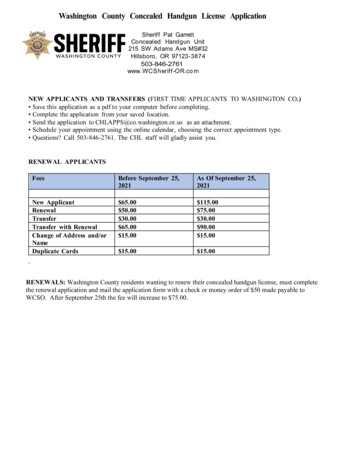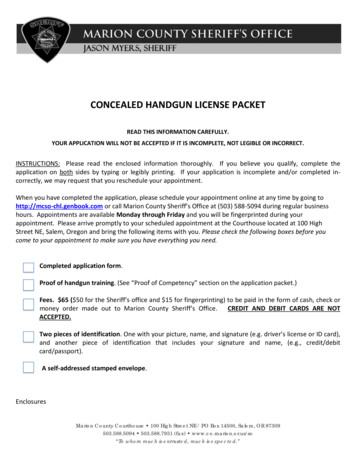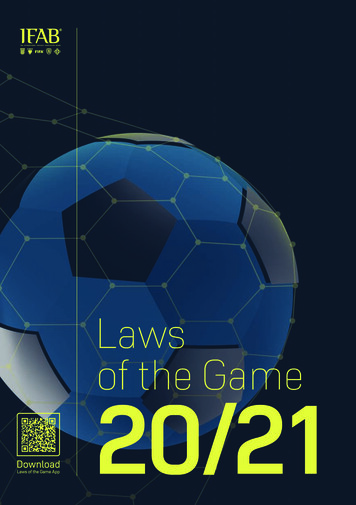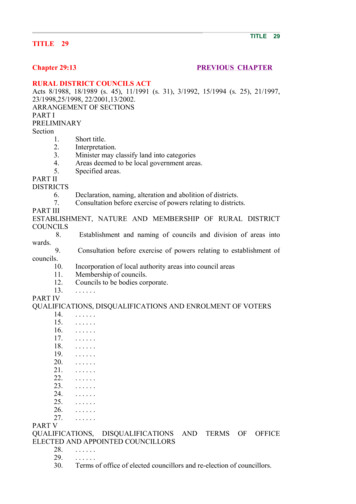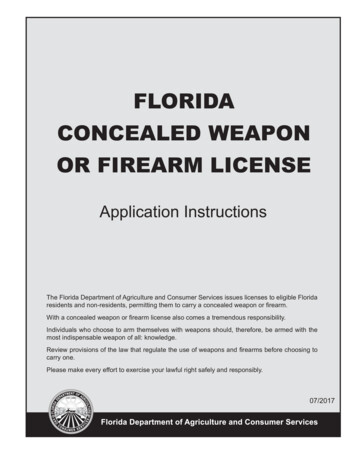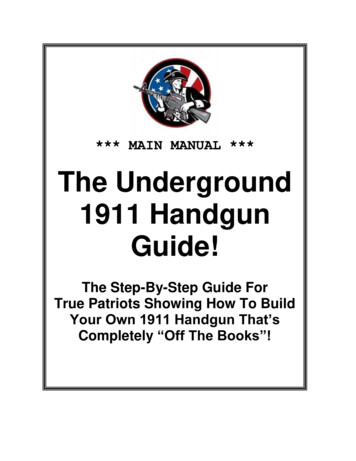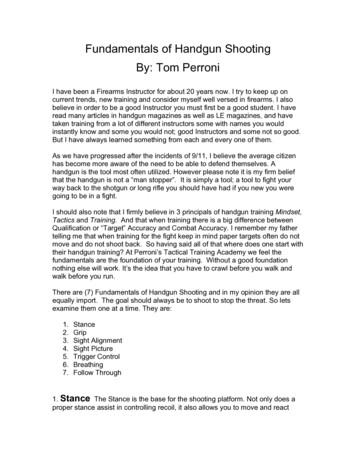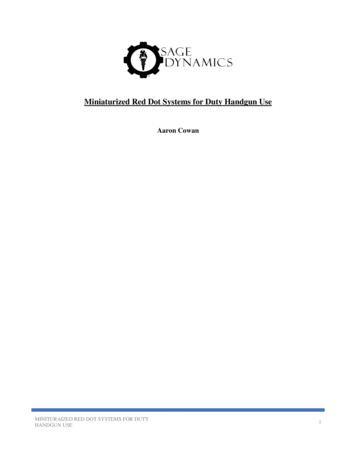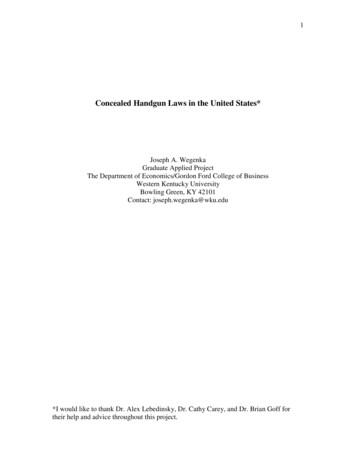
Transcription
1Concealed Handgun Laws in the United States*Joseph A. WegenkaGraduate Applied ProjectThe Department of Economics/Gordon Ford College of BusinessWestern Kentucky UniversityBowling Green, KY 42101Contact: joseph.wegenka@wku.edu*I would like to thank Dr. Alex Lebedinsky, Dr. Cathy Carey, and Dr. Brian Goff fortheir help and advice throughout this project.
2AbstractThis paper examines concealed handgun laws in the United States with theultimate goal of measuring the effect those laws have on crime rates. Existing literatureon the subject of concealed handgun laws shows conflicting results and opinions. Mostauthors agree that more research on this subject needed. In this study, states are matchedinto pairs based on their probability of adopting certain concealed handgun laws. Atechnique similar to the one used by Fryer and Greenstone (2007) is used to match thestates. This is a new approach to examining concealed handgun laws. States that adoptedthe laws are compared to states with similar probabilities that did not adopt the law. Theresults of this project show evidence that laws allowing citizens to carry concealedweapons do indeed lower crime rates, in particular, violent crime rates.
3Part IIntroductionThere are often questions about what the founding fathers of our nation trulyintended in the words of the Declaration of Independence and the Constitution. TheSecond Amendment to the Constitution of the United States of America is one of themost popular issues in government and politics in recent history. The exact wordsinclude: “A well regulated Militia, being necessary to the security of a free State, theright of the people to keep and bear Arms, shall not be infringed.”1 Some interpretationsof this have changed over the history of our nation. Individual states also have differentinterpretations of what the founding fathers meant by the Second Amendment.The issue of gun control is a hotly debated topic today that is often brought up inpolitical campaigns during election season or often after shootings covered by the media.In recent years, there have been a number of school shootings which have left a numberof young people dead, including the violent massacre at Virginia Tech University.2Immediately following the tragedy, there was a great deal of talk in the media as well asthe Virginia state legislature on the subject of gun control.In the 2008 presidential election, the issue was brought up once again. SenatorJohn McCain had the support of the National Rifle Association while Senator Barack1The Second Amendment to the United States Constitution: “A well regulated militia being necessary to thesecurity of a free State, the right of the People to keep and bear arms shall not be infringed.” Is a part of theUnited States Bill of Rights. The U.S. Supreme Court has upheld the right of citizens to own firearms,saying a ban would violate the Second Amendment rights of American citizens. Most recently, in 2008, theUnited States Supreme Court ruled that a District of Columbia law banning possession of handguns in thehome was in violation of the Second Amendment in the case: District of Columbia v. Heller, 128 S.Ct.2783 (2008).2On April 16th 2007, a gunman opened fire on students and faculty at Virginia Polytechnic Institute andState University killing 32 and injuring others before committing suicide. It is the deadliest shootingincident during peacetime in United States history. Source: Deadliest Shootings in the U.S., MSNBC.
4Obama had the support of most gun control advocates. Following the election of BarackObama, gun and ammunition sales increased despite an economy in recession, whichmany attribute to fears that President Obama would restrict gun ownership and gun saleseven more.3Concealed gun laws have been a very important part of the gun controldiscussion. Many have challenged and defended the right to carry a firearm concealed onor near the person. The history of concealed handgun law as well as a background on theexplanations and theories behind many gun control policies are in the following twosections of this paper. The issue of gun control has been and continues to be an importantissue in our nation‟s history.History of Concealed Handgun LawAccording to Cramer and Kopel (1995), there were laws in place in the yearsbefore the Civil War that addressed the issue of concealed handguns. Some states bannedthe carrying of concealed handguns, even including on-duty law enforcement agents. Inthe 1897 Supreme Court case Robertson vs. Baldwin, 165 U.S. 275, the Court decidedthat laws regulating concealed firearms did not infringe upon the right “to keep and beararms”, and therefore was not a violation of the Second Amendment.In the 1920s and 1930s many states adopted "A Uniform Act to Regulate the Saleand Possession of Firearms." This law prohibited unlicensed concealed carrying of afirearm. Most states understood the need for law enforcement and some others to carry aconcealed weapon and adopted provisions that allowed concealed carry for certain3There are a number of articles that reported on the rise in gun sales. Gun and ammunition sales actuallybegan to rise when Senator Obama clearly led in polls. The numbers continued to rise in the weeks andmonths after the election. An article from CNN, Gun Sales Surge After Obama’s Election, tells more onthis story.
5individuals. Vermont, one state that did not adopt the Uniform Act, did not adopt astatute prohibiting concealed handguns. Vermont is unique in having no statutesprohibiting or regulating the concealed carry of handguns except with the intent to injuresomeone.4After World War II, New Hampshire, Washington, and Connecticut were the firststates to adopt what are known as “shall issue” statutes. Grossman and Lee (2008)discuss the differences in the laws. In shall issue states, authorities are normally requiredto issue a right to carry permit unless there is a cause disqualifying the applicant (such asbeing a convicted felon), and the authorities do not have discretion in deciding whether ornot the applicant has reasonable need for the permit. Today there are thirty-nine shallissue states in the United States in which officials cannot deny a concealed-carry permitto a citizen as long as that citizen meets certain basic requirements.5 May issue statesalso require a permit to carry a concealed weapon; however, the issuing of such permits isat the discretion of government officials. May issue laws allow the authorities a greatdeal of power to deny applications for concealed carry permits. May issue laws generallyrequire applicants for permits to give a reason for why it is necessary for them to carry aconcealed weapon. Nine states have may issue laws. Two states, Vermont and Alaskaare said to be unrestricted, with Alaska often also referred to as a “shall issue” state.While Alaska automatically issues permits to residents who meet the criteria, Vermont, asmentioned earlier, has no statutes regarding concealed carry permits.6 7 No state has evergone from being a “shall issue state” to being a “may issue” state.4While it may seem somewhat ambiguous, this is how Vermont law is written. Statute Title 13: Section4003, from the Office of the Attorney General of Vermont.5See Table 1 at the end of this paper for a complete list of the year each state adopted a shall issue law.6Alaska law can be found on the Alaska Division of Statewide Services webpage ensing/concealedhandguns.aspx
6Explanations For and Against Gun ControlDezhbakhsh and Rubin (1998) discussed the possible effects of gun control laws.The two possible effects the authors discuss are the “facilitating effect” and the “deterrenteffect”. The facilitating effect is an increase in crime due to an increase in gun ownershipresulting from laws that allow easier access to and ownership of firearms. The deterrenteffect on the other hand, is that if potential victims‟ likelihood of owning a gun increases,then the criminals‟ uncertainty of the victims‟ gun ownership increases. This wouldlikely result in a decrease in crime. The more often those victims carry a gun and use it inself-defense, the more risk a criminal expects to be taking on when attacking a victim.The authors‟ opinion is that depending on the population characteristics of a certain area,gun laws may either lead to an increase or decrease in crime rates.In economics these effects may be thought of as the substitution effect andincome effect often discussed as a part of consumer theory. In this model, the“consumer” is a person who may or may not commit a crime. Instead of incomesincreasing, the availability of guns is increasing (the facilitating effect). The substitutioneffect, which addresses changes in relative prices to consumers, is the change in therelative price of committing crimes. The price of committing a crime could be the risk ofbeing apprehended or even shot (the deterrent effect).Lott (2001) has done extensive work in law and economics as well as publicchoice theory. According to Lott, areas where carrying a concealed weapon is legal have7Vermont law, The Vermont Statutes Online, Title 13: Crimes and Criminal Procedures, Chapter 85:Weapons.
7a 69 percent decrease in the death rate from public multiple shootings like those atVirginia Tech and Columbine High School8.9Lott (2001) discusses the National Academy of Sciences report on gun control.The Clinton administration set up a panel, made up mostly of gun control advocates, atthe National Academy of Sciences to study the affect of gun control laws, however theirfocus was to examine the negative side of guns. A good example of the public choicemodel, the Clinton administration‟s aim was to appear tough on crime through theirassault weapons ban and Brady Act, when in fact according to Lott, “the panel couldn‟tidentify a single gun control regulation that reduced violent crime, suicide or accidents.”The 328 page report was based on 253 journal articles, 99 books, 43 governmentpublications, and the panel‟s own empirical work, but they still could not find anyevidence of increased gun control laws reducing crime rates. The panel however decidedto ignore that perhaps their questions had been answered, and instead they called formore funding to continue their research.8An important point that must be addressed is how the laws affect a person‟sdecision making. In places where it is illegal to carry a concealed firearm, law-abidingcitizens are the ones not carrying while criminals are the ones that are carrying firearms.Laws restricting the use of guns therefore benefit those who intend to use them forcriminal activity. Law abiding citizens lose their right to defend themselves with a gun.Gun laws, such as concealed-carry laws, do very little to stop criminals from breaking the8On April 20 1999, two gunmen opened fire and set off explosive devices killing 15 and injuring more atColumbine High School in Littleton, Colorado. Source: Deadliest Shootings in the U.S., MSNBC9This paragraph was taken from my 2007 Senior Assessment paper for my Bachelor of Science Degree inBusiness Economics, Determinants of Violent Crime Rates and the Affect of Gun Control.8This paragraph was taken from my 2007 Senior Assessment paper for my Bachelor of Science Degree inBusiness Economics, Determinants of Violent Crime Rates and the Affect of Gun Control.
8law.10 Despite a law prohibiting possession of firearms within 1000 feet of a school inthe United States, there have still been a number of fatal school shootings across thenation in the recent decades.11The last important issue that is often discussed with an increase in gun ownershipis the number of accidental shootings. While this paper does not study accidentalshootings or cases of mistaken identity in shootings, both numbers may be affected byconcealed gun laws and an increase in the number of people carrying a firearm.Proponents of gun control (opponents of the right to carry concealed firearms) argue thatless gun control leads to an increase in the number of accidental shootings. Miguel A.Faria Jr., M.D., editor of the Medical Sentinel, has done much research on the topic ofgun control. In 1997 and again in 2001, Faria discussed the work of the AmericanMedical Association‟s (AMA) campaign against domestic violence. Dr. ArthurKellermann, head of the Emory University School of Public Health, was a leadinvestigator in the AMA‟s campaign. Dr. Kellermann (1986) claimed that, "scientificresearch proved that defending oneself or one's family with a firearm in the home isdangerous and counter productive, claiming „a gun owner is 43 times more likely to kill afamily member than an intruder.‟” Dr. Edgar Suter, Chairman of Doctors for Integrity inPolicy Research, found many flaws in this study however. Dr. Suter writes: “The truemeasure of the protective benefits of guns are the lives and medical costs saved, theinjuries prevented, and the property protected --- not the burglar or rapist body count.Since only 0.1 - 0.2 percent of defensive uses of guns involve the death of the criminal,10In the real world, there are many people that may fit in both the criminal and non-criminal categoriesbased on different criteria. This study simply defines a “law abiding citizen” as a person who follows thegun laws in place. Once a person chooses to break a gun law, he or she is no longer considered “lawabiding”.11The GUN-FREE SCHOOL ZONES ACT OF 1990 prohibits the possession or discharge of a firearm in aschool zone (defined as being within 1,000 feet of a school).
9any study, such as this, that counts criminal deaths as the only measure of the protectivebenefits of guns will expectedly underestimate the benefits of firearms by a factor of 500to 1,000” (Faria, 2001).12The Effects of Concealed Handgun Laws (A Brief Review of Past Results)Lott vs. OthersJohn Lott is not the only one to find that crime rates were lower in areas whereconcealed carry is legal. On the other hand, there are those that have questioned thefindings of Lott and others.Lott and Mustard (1997) found that shall issue laws reduce the number of violentand property crime rates without increasing accidental deaths. This reduction in crimerates is, according to Lott and Mustard, due to the deterrent effect. Their study includedcross-sectional data from counties in the United States. In addition to crime rates, theauthors put a monetary value on concealed carry laws:The estimated annual gain from all remaining states adopting these lawswas at least 5.74 billion in 1992. The annual social benefit from anadditional concealed handgun permit is as high as 5,000.(Abstract, Lott and Mustard, 1997)Dezhbakhsh and Rubin (1998) believe that Lott and Mustard‟s findings aresuspect. In their own study, they aim to overcome what they call shortcomings of theLott and Mustard study. Their study tried to measure how various unique factors in acounty might affect the magnitude of the change in crime rates as a result of shall issue12Some of this paragraph was taken from my 2007 Senior Assessment paper for my Bachelor of ScienceDegree in Business Economics, Determinants of Violent Crime Rates and the Affect of Gun Control.
10laws being enacted. They found the results to be smaller than those in the studyconducted by Lott and Mustard. In their conclusions they list these effects:For murder, for example, there is only at best a small reducing effect. Forrobbery, many states experience increases in crime. For other crimes,results are ambiguous, with some counties showing predicted increases,and some predicted decreases (p 473).Webster, Vernick & Ludwig (1998) discuss their disagreement with Lott andMustard‟s 1997 findings. The main problems these authors have with the findings ofLott and Mustard are not taking into account crime cycles and omitted variable bias.Some important variables that Lott and Mustard are accused of omitting include changesin local drug markets, police practices, and poverty. Webster (et al) conclude that shallissue laws do not reduce crime rates:Subsequent research correcting for several of the problems with Lott andMustard's study shows no evidence that these laws reduce violent crime(p 983).Lott responded to Webster (et al) in the same issue of the American Journal ofPublic Health. Lott claims that his study takes into account crime rate trends over the 16years of data in the study. Lott measures crime rate patterns before and after the adoptionof laws. Other studies, Lott admits have not included many important variables, but thestudy by Lott and Mustard accounted for changes in county demographics (Lott, 1998).Another study by Lott, along with Stephen G. Bronars, shows the “spillover”effect of shall issue laws. Criminals are said to move from one community to another
11more in response to changes in concealed handgun laws than in response to arrest rates.The spillovers are largest for property crimes and happen immediately and continue toincrease over time after adoption of the law. This is further evidence that supports theopinion of Lott that concealed handguns actually do deter criminals (Bronars & Lott,1998).The next section, Part II, will discuss matching states based on their probability ofa state adopting a “shall issue” law. Part III will compare the effects of a state adoptingshall issue laws on the crime rates.
12Part IIUsing Probability of Adopting the Law to Match StatesThis study uses the approach by Fryer and Greenstone (2007) who studied thecauses and consequences of attending historically black universities. In their paper, theyestimate the probability of a student attending a historically black college or universityusing a probit model. Once probabilities are estimated, students who attended bothhistorically black colleges and universities and those who attended traditionally whiteinstitutions with similar probabilities of attending a historically black college oruniversity are matched into pairs. Outcomes of these pairs, years after completingcollege, are then compared. This method allows the authors to gain information onwhether the type of school attended is a determining factor of future outcomes or if othervariables may have existed prior to choosing a college that is responsible for futureoutcomes.This study matches states into pairs using the probability of each state adopting a“shall issue” law. The outcomes (crime rates) of the matched pairs can then be compared.States that adopted shall issue laws are compared to the matched pair states that did notadopt the law but should have, given their similar probability to those states that did. Bymatching states based on their probability to adopt a law, we are able to match states withsimilar characteristics important in determining when and why states adopt suchlegislation. This type of study is superior to cross-sectional analysis among all states inthe U.S. due to the fact that we are comparing states with similar characteristics indifferent years. This method should lower the amount of biased in the estimates due toimportant omitted variables.
13In trying to generate the probability of a state adopting a shall issue law in acertain year, the variables that affect whether or not the law is adopted must bedetermined first. For this part, the study by Grossman and Lee (2008) is very useful. Intheir article, the authors state that the goal of their paper is to “ explain the timing andpattern of the adoption of different gun control laws across U.S. states during the past 40yr.” (pg 198) The next section will discuss the variables and data used to predictprobability.Data/VariablesThe data and variables used for this study are for the years 1960 through 2001,taken directly from the article by Grossman and Lee.13 In their study, the focus is on thevariables affecting whether or not a state adopts a shall issue gun permit law and thetiming of the adoption of such laws. Forty-eight states were used, with Vermont andNew Hampshire already being classified as shall issue states prior to 1960. Thedependent variable used in their study was whether or not a state is “shall issue”. Adummy variable was used with a “1” meaning the state had adopted shall issue and a “0”meaning the state had not adopted the law. Classification of states as shall issue stateswas determined by the authors on a case-by-case basis.1413The data used for this study is what was provided by Dr. Richard S. Grossman of Wesleyan Universityafter I requested the data via e-mail. I explained to him that I wanted to use his data and what he had doneto estimate the probability of a state adopting a shall issue law for my applied project. It should be notedthat Dr. Grossman was unsure whether this was the exact same data set used for his study with Stephen A.Lee. I would like to thank Dr. Grossman for providing me with this data set to use in this study.14See Grossman & Lee, 2008; page 202, Section “IV. Data” for further explanation.
14A. CrimeThe first variable mentioned in the Grossman and Lee (2008) article is crime.Crime is often a reason given by those who favor and those who oppose shall issue laws.The authors mention:At a rally in Salt Lake City prior to the adoption of Utah’s “shall issue” law,proponents argued that a rising crime rate made it important for law-abiding citizens tobe able to purchase guns.15On the other side of this issue, proponents of gun control argue that reducing the numberof guns would reduce the crime rate. Crime rates were taken from the FBI‟s UniformCrime Report, U.S. Department of Justice, Bureau of Justice Statistics, 1960 – 2001.B. Neighboring JurisdictionsThe next variable mentioned in the article is “neighboring jurisdiction”.Neighboring states‟ laws are said to influence how a state decides to set their own laws.The passage of shall issue laws in neighboring states should make a state want to adopt ashall issue law itself. Grossman and Lee point out that one reason this may be aninfluence is that politicians supporting the right to carry and overall gun rights maysimply use “keeping up with surrounding states” as way to push their initiatives. Bronarsand Lott (1998) discuss the “spillover effect” of shall issue laws. That is, criminals willlikely move into nearby or adjacent jurisdictions where the gun laws are stricter and therisk of a victim using a gun is less. By adopting laws that are similar to surroundingareas, criminals have less incentive to move to that area. This variable is measured by thepercentage of each state‟s border that is contiguous to a shall issue state.15Grossman and Lee referenced “Salt Lake City Tribune, January 29, 1995, p. B3.”
15C. Urban PopulationGrossman and Lee discuss that it seems to be the case that states with greater ruralpopulations tend to be shall issue states while states with very urbanized populations aremay issue. The logic here is that urban areas may believe that concealed carry should bemore restricted. Those in rural areas might be more accustomed to owning guns andhunting and therefore more accustomed to and comfortable with the idea of concealedcarrying of firearms. To measure this variable, the authors used the percentage of astate‟s population that lives in a metropolitan statistical area according to the U.S.Department of Commerce, Bureau of the Census (1960-1961).D. Political FactorsPolitical factors were also included by Grossman and Lee. Republicans tend to bemore in favor of second amendment (gun) rights while democrats tend to favor strictergun control. According to Lott and Mustard (1997), states that have right to carry lawstended to be Republican with large NRA memberships.16 This variable is measured bythe political party affiliation of the state‟s governor along with which party has controlover the state legislature.Brief Review of Results from Grossman and LeeGrossman and Lee show results for eleven different models with variouscombinations of variables. All variables were found to be significant in explaining theadoption of shall issue laws except political factors. Crime itself was not found to be16NRA stands for National Rifle Association.
16significant, but the change in crime over both three and five year periods was found to besignificant (Grossman & Lee, 2008).Explaining Matched Pairs and ProbitThe variables from Grossman and Lee were used to estimate the probability for astate adopting a “shall issue” law using a probit model. The states with similarprobabilities (within .05) are matched into pairs. States with similar probabilities wouldhave similar characteristics that affect whether or not a state adopts a shall issue law.Next, the crime rates for matched pairs are compared to help determine the effect of thelaw. For example, Indiana adopted a shall issue law in 1980. Nevada had a similarprobability of adopting the law in 2001 but did not. The crime rates of the two states inthe given years are then compared. This is repeated for two years and three years after thegiven years to see the effects of the shall issue law on crime rates.In total, Grossman and Lee‟s dataset contained over 1700 observations. From1960 through 2001, there were 29 states that adopted shall issue law. Therefore there areonly 29 observations with SI (Shall Issue Law) 1.17 This poses a problem for runningprobit effectively, having close to 1700 observations for which SI 0. In order to bringthe number of observations with SI 0 and SI 1 closer together, the data for the yearshall issue was adopted along with the data for the year 8 years prior to adoption are used.For states in which the law was not adopted during the time frame, 2001 was considered“0 years until adoption of law” and the data for “8 years until adoption of law” was alsoused as in the other observations. This gave a total number of 96 observations for thisprobit model.17SI (Shall Issue): 1 shall issue law adopted, 0 shall issue law not adopted.
17Using the observations for “8 years until adoption of law” may seem somewhatarbitrary but was chosen as it better predicted the outcomes of states. One reason for thismay be that in the years immediately before the adoption of law, the characteristicsdetermining whether a state is to adopt a law or not are similar to those in the year thelaw is adopted. Taking data from 8 years prior to adoption of the law allows for thosecharacteristics to change. Political factors, neighboring jurisdictions, crime rates, andurban populations may not change much from one year to the next but over 8 years thosevariables can be very different.ModelThe equation estimate with probit is:Shall Issue Dummy a b1Crime* b2Urban Population b3Political Factors** b4Percent border b5Population e* b1Crime includes various variables for crime:QniQNvQNpdQNI3dQNI5dQNV3dQNV5Total crime index (QNI2 is crime index squared)Violent Crime IndexProperty Crime index (not using this)3-year change in total crime index5-year change in total crime index3-year change in violenbt crime index5-year change in violenbt crime index**b3Political Factors:DDRRDemocrats control house, senate, governorRepublicans control house, senate, governorOther variables:SIPopSMSAPctBorderSI“shall issue” Dummy, 1 adopted law, 0 law not adoptedPopulationPercent of population living in urban areaspercent state's border that touches a "shall issue" state
18Using the predicted probabilities based on this model, we are able to match thestates based on similar probabilities of adopting shall issue law. The matched pairsresulting from this model can be seen in Table 2 at the end of this paper. Some states arematched with only one other state while other states have multiple matches such asMichigan with twelve matches. There are sixty-four matched pairs of states that haveadopted shall issue laws with states that have not adopted shall issue in the given year.States can be matched with more than one other state.The next section, Part III, will discuss the comparison of crime rates in matchedstate pairs.
19Part IIIDataData for individual state crime rates is taken from the United States Departmentof Justice, Bureau of Justice Statistics. The range for this data is 1960 – 2007 and ismeasured annually. Violent crime rates and property crime rates are examined separatelyas there is an expectation of differing effects of concealed carry laws on the differenttypes of crimes, based on previous studies and literature.First ApproachAs mentioned above in Part II, states have been matched based on the probabilitythat they will adopt shall issue legislation. To measure the effects of the law, the crimerates in states that adopted shall issue legislation are compared to their matched pair orpairs that did not adopt the law.The first attempt to measure this effect was to take the difference in crime rates ineach given year.18 For example, Oklahoma adopted shall issue in 1995 and was matchedwith 1981 West Virginia. The difference for these would be calculated as:Difference (Oklahoma ViolentCrime 1995) – (WestVirginia ViolentCrime 1981)For states that have more than one match such as Arkansas, the average of the crime ratesof matched states is subtracted. The calculation is as follows:18For the rest of this project, years should be thought of as the number of years until shall issue is adopted(or should have been adopted in the case of the matched pair states) or the number of year after shall issuewas adopted.
20Difference (Arkansas ViolentCrime 1995) – ((Connecticut ViolentCrime 1961 Florida ViolentCrime 1979 Maine ViolentCrime 1977) / 3)This difference is calculated for all states and their matched pairs. The difference is alsocalculated for the year prior to adoption and then calculated for the next four years afterthe adoption of the law. Those differences are then compared. If the law is affecting thecrime rates, there may be a
8 On April 20 1999, two gunmen opened fire and set off explosive devices killing 15 and injuring more at Columbine High School in Littleton, Colorado. Source: Deadliest Shootings in the U.S., MSNBC 9 This paragraph was taken from my 2007 Senior Assessment paper for my Bachelor of Science Degree in


